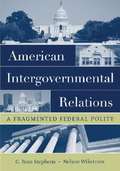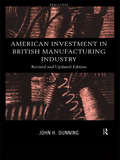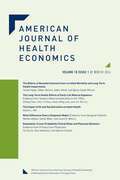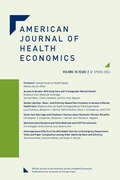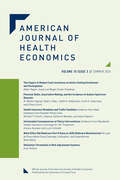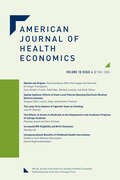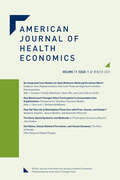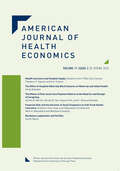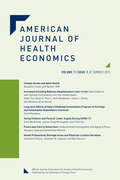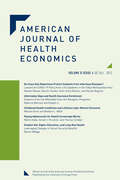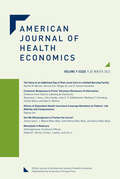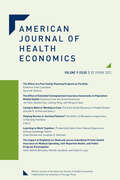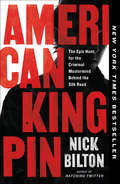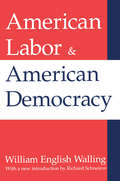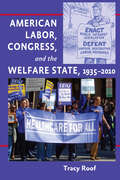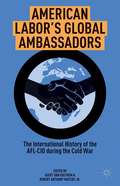- Table View
- List View
American Intergovernmental Relations: A Fragmented Federal Polity
by G. Ross Stephens Nelson WikstromThe one constant in the American federal system is change--change that is not always beneficial. American Intergovernmental Relations: A Fragmented Federal Polity examines how the dynamic social, economic, and political forces that impinge on American government at all levels shape the waythat our federal system functions. Stephens and Wikstrom--both senior scholars specializing in federalism, intergovernmental relations, and fiscal policy--offer concise, comprehensive, and easy-to-understand coverage of these materials. Beginning with the key elements of federalism, the authors trace these principles as they haveevolved since the founding of the republic and through the various phases and types of federal arrangements as they exist today. They examine and analyze the extreme complexity of the system and the cooperative and conflicting components of vertical and horizontal intergovernmental relations. Stephens and Wikstrom also discuss the impact of public policy and intergovernmental relations on American society in light of rising globalism, rapidly changing technology, and new security concerns. Featuring relevant case studies from the headlines, American Intergovernmental Relations is anideal text for undergraduate and graduate courses in federalism and intergovernmental relations. It is also an excellent text for a different approach to a course in American government.
American Intergovernmental Relations: Foundations, Perspectives and Issues (3rd edition)
by Laurence J. O'Toole Jr.Introduces classic essays and contemporary problems - all put in historic perspective by the editor's insightful and superb commentary. - From back cover
American International Group - 2010
by Jay W. Lorsch Melissa BartonThe AIG Board underwent significant restructuring after the company was bailed out by the U.S. government in September 2008 in the midst of the financial crisis.
American Inventors, Entrepreneurs, and Business Visionaries
by Charles W. CareyFaced with limiting his coverage to less than 300 people, Carey (US history and western civilization, Lynchburg College and Central Virginia Community College) had little trouble including the famous figures that would be expected in such an account. After that, he strove to represent all categories of American life in order to demonstrate that people from all backgrounds have been and therefore can be successful innovators and visionaries in business. Annotation c. Book News, Inc., Portland, OR (booknews.com)
American Investment in British Manufacturing Industry
by John DunningThis classic work, first published in 1958, is a seminal text in international business history. This new, substantially updated and revised edition is being published on the fortieth anniversary of the first edition. Features of the revised edition include: * a new introduction * a new concluding chapter * amendments and additions to the original text * a new statistical appendix which examines the main features and significance of the US penetration of UK industry over the past four decades. Professor Dunning is one of the most internationally renowned and respected scholars in international business research. The updated version of this highly regarded book is a major contribution to studies in international business history.
American Journal of Health Economics, volume 10 number 1 (Winter 2024)
by American Journal of Health EconomicsThis is volume 10 issue 1 of American Journal of Health Economics. The American Journal of Health Economics (AJHE) provides a forum for the in-depth analysis of health care markets and individual health behaviors. The articles appearing in AJHE are authored by scholars from universities, private research organizations, government, and industry. Subjects of interest include competition among private insurers, hospitals, and physicians; impacts of public insurance programs; pharmaceutical innovation and regulation; medical device supply; the rise of obesity and its consequences; the influence and growth of aging populations; and much more. The journal is published for the American Society of Health Economists (ASHEcon), which is a professional, non-profit organization dedicated to promoting excellence in health economics research in the United States.
American Journal of Health Economics, volume 10 number 2 (Spring 2024)
by American Journal of Health EconomicsThis is volume 10 issue 2 of American Journal of Health Economics. The American Journal of Health Economics (AJHE) provides a forum for the in-depth analysis of health care markets and individual health behaviors. The articles appearing in AJHE are authored by scholars from universities, private research organizations, government, and industry. Subjects of interest include competition among private insurers, hospitals, and physicians; impacts of public insurance programs; pharmaceutical innovation and regulation; medical device supply; the rise of obesity and its consequences; the influence and growth of aging populations; and much more. The journal is published for the American Society of Health Economists (ASHEcon), which is a professional, non-profit organization dedicated to promoting excellence in health economics research in the United States.
American Journal of Health Economics, volume 10 number 3 (Summer 2024)
by American Journal of Health EconomicsThis is volume 10 issue 3 of American Journal of Health Economics. The American Journal of Health Economics (AJHE) provides a forum for the in-depth analysis of health care markets and individual health behaviors. The articles appearing in AJHE are authored by scholars from universities, private research organizations, government, and industry. Subjects of interest include competition among private insurers, hospitals, and physicians; impacts of public insurance programs; pharmaceutical innovation and regulation; medical device supply; the rise of obesity and its consequences; the influence and growth of aging populations; and much more. The journal is published for the American Society of Health Economists (ASHEcon), which is a professional, non-profit organization dedicated to promoting excellence in health economics research in the United States.
American Journal of Health Economics, volume 10 number 4 (Fall 2024)
by American Journal of Health EconomicsThis is volume 10 issue 4 of American Journal of Health Economics. The American Journal of Health Economics (AJHE) provides a forum for the in-depth analysis of health care markets and individual health behaviors. The articles appearing in AJHE are authored by scholars from universities, private research organizations, government, and industry. Subjects of interest include competition among private insurers, hospitals, and physicians; impacts of public insurance programs; pharmaceutical innovation and regulation; medical device supply; the rise of obesity and its consequences; the influence and growth of aging populations; and much more. The journal is published for the American Society of Health Economists (ASHEcon), which is a professional, non-profit organization dedicated to promoting excellence in health economics research in the United States.
American Journal of Health Economics, volume 11 number 1 (Winter 2025)
by American Journal of Health EconomicsThis is volume 11 issue 1 of American Journal of Health Economics. The American Journal of Health Economics (AJHE) provides a forum for the in-depth analysis of health care markets and individual health behaviors. The articles appearing in AJHE are authored by scholars from universities, private research organizations, government, and industry. Subjects of interest include competition among private insurers, hospitals, and physicians; impacts of public insurance programs; pharmaceutical innovation and regulation; medical device supply; the rise of obesity and its consequences; the influence and growth of aging populations; and much more. The journal is published for the American Society of Health Economists (ASHEcon), which is a professional, non-profit organization dedicated to promoting excellence in health economics research in the United States.
American Journal of Health Economics, volume 11 number 2 (Spring 2025)
by American Journal of Health EconomicsThis is volume 11 issue 2 of American Journal of Health Economics. The American Journal of Health Economics (AJHE) provides a forum for the in-depth analysis of health care markets and individual health behaviors. The articles appearing in AJHE are authored by scholars from universities, private research organizations, government, and industry. Subjects of interest include competition among private insurers, hospitals, and physicians; impacts of public insurance programs; pharmaceutical innovation and regulation; medical device supply; the rise of obesity and its consequences; the influence and growth of aging populations; and much more. The journal is published for the American Society of Health Economists (ASHEcon), which is a professional, non-profit organization dedicated to promoting excellence in health economics research in the United States.
American Journal of Health Economics, volume 11 number 3 (Summer 2025)
by American Journal of Health EconomicsThis is volume 11 issue 3 of American Journal of Health Economics. The American Journal of Health Economics (AJHE) provides a forum for the in-depth analysis of health care markets and individual health behaviors. The articles appearing in AJHE are authored by scholars from universities, private research organizations, government, and industry. Subjects of interest include competition among private insurers, hospitals, and physicians; impacts of public insurance programs; pharmaceutical innovation and regulation; medical device supply; the rise of obesity and its consequences; the influence and growth of aging populations; and much more. The journal is published for the American Society of Health Economists (ASHEcon), which is a professional, non-profit organization dedicated to promoting excellence in health economics research in the United States.
American Journal of Health Economics, volume 8 number 4 (Fall 2022)
by American Journal of Health EconomicsThis is volume 8 issue 4 of American Journal of Health Economics. The American Journal of Health Economics (AJHE) provides a forum for the in-depth analysis of health care markets and individual health behaviors. The articles appearing in AJHE are authored by scholars from universities, private research organizations, government, and industry. Subjects of interest include competition among private insurers, hospitals, and physicians; impacts of public insurance programs; pharmaceutical innovation and regulation; medical device supply; the rise of obesity and its consequences; the influence and growth of aging populations; and much more. The journal is published for the American Society of Health Economists (ASHEcon), which is a professional, non-profit organization dedicated to promoting excellence in health economics research in the United States.
American Journal of Health Economics, volume 9 number 1 (Winter 2023)
by American Journal of Health EconomicsThis is volume 9 issue 1 of American Journal of Health Economics. The American Journal of Health Economics (AJHE) provides a forum for the in-depth analysis of health care markets and individual health behaviors. The articles appearing in AJHE are authored by scholars from universities, private research organizations, government, and industry. Subjects of interest include competition among private insurers, hospitals, and physicians; impacts of public insurance programs; pharmaceutical innovation and regulation; medical device supply; the rise of obesity and its consequences; the influence and growth of aging populations; and much more. The journal is published for the American Society of Health Economists (ASHEcon), which is a professional, non-profit organization dedicated to promoting excellence in health economics research in the United States.
American Journal of Health Economics, volume 9 number 2 (Spring 2023)
by American Journal of Health EconomicsThis is volume 9 issue 2 of American Journal of Health Economics. The American Journal of Health Economics (AJHE) provides a forum for the in-depth analysis of health care markets and individual health behaviors. The articles appearing in AJHE are authored by scholars from universities, private research organizations, government, and industry. Subjects of interest include competition among private insurers, hospitals, and physicians; impacts of public insurance programs; pharmaceutical innovation and regulation; medical device supply; the rise of obesity and its consequences; the influence and growth of aging populations; and much more. The journal is published for the American Society of Health Economists (ASHEcon), which is a professional, non-profit organization dedicated to promoting excellence in health economics research in the United States.
American Journal of Health Economics, volume 9 number 3 (Summer 2023)
by American Journal of Health EconomicsThis is volume 9 issue 3 of American Journal of Health Economics. The American Journal of Health Economics (AJHE) provides a forum for the in-depth analysis of health care markets and individual health behaviors. The articles appearing in AJHE are authored by scholars from universities, private research organizations, government, and industry. Subjects of interest include competition among private insurers, hospitals, and physicians; impacts of public insurance programs; pharmaceutical innovation and regulation; medical device supply; the rise of obesity and its consequences; the influence and growth of aging populations; and much more. The journal is published for the American Society of Health Economists (ASHEcon), which is a professional, non-profit organization dedicated to promoting excellence in health economics research in the United States.
American Journal of Health Economics, volume 9 number 4 (Fall 2023)
by American Journal of Health EconomicsThis is volume 9 issue 4 of American Journal of Health Economics. The American Journal of Health Economics (AJHE) provides a forum for the in-depth analysis of health care markets and individual health behaviors. The articles appearing in AJHE are authored by scholars from universities, private research organizations, government, and industry. Subjects of interest include competition among private insurers, hospitals, and physicians; impacts of public insurance programs; pharmaceutical innovation and regulation; medical device supply; the rise of obesity and its consequences; the influence and growth of aging populations; and much more. The journal is published for the American Society of Health Economists (ASHEcon), which is a professional, non-profit organization dedicated to promoting excellence in health economics research in the United States.
American Journey: On The Road With Henry Ford, Thomas Edison, And John Burroughs
by Wes Davis“Jaunty.… Davis excels in making his characters come alive on the page.” —Christoph Irmscher, Wall Street Journal The epic road trips—and surprising friendship—of John Burroughs, nineteenth-century naturalist, and Henry Ford and Thomas Edison, inventors of the modern age. In 1913, an unlikely friendship blossomed between Henry Ford and famed naturalist John Burroughs. When their mutual interest in Ralph Waldo Emerson led them to set out in one of Ford’s Model Ts to explore the Transcendentalist’s New England, the trip would prove to be the first of many excursions that would take Ford and Burroughs, together with an enthusiastic Thomas Edison, across America. Their road trips—increasingly ambitious in scope—transported members of the group to the 1915 Panama–Pacific International Exposition in San Francisco, the Adirondacks of New York, and the Green Mountains of Vermont, finally paving the way for a grand 1918 expedition through southern Appalachia. In many ways, their timing could not have been worse. With war raging in Europe and an influenza pandemic that had already claimed thousands of lives abroad beginning to plague the United States, it was an inopportune moment for travel. Nevertheless, each of the men who embarked on the 1918 journey would subsequently point to it as the most memorable vacation of their lives. These travels profoundly influenced the way Ford, Edison, and Burroughs viewed the world, nudging their work in new directions through a transformative decade in American history. In American Journey, Wes Davis re-creates these landmark adventures, through which one of the great naturalists of the nineteenth century helped the men who invented the modern age reconnect with the natural world—and reimagine the world they were creating.
American Kingpin: The Epic Hunt for the Criminal Mastermind Behind the Silk Road
by Nick BiltonThe unbelievable true story of the man who built a billion-dollar online drug empire from his bedroom—and almost got away with it In 2011, a twenty-six-year-old libertarian programmer named Ross Ulbricht launched the ultimate free market: the Silk Road, a clandestine Web site hosted on the Dark Web where anyone could trade anything—drugs, hacking software, forged passports, counterfeit cash, poisons—free of the government’s watchful eye. It wasn’t long before the media got wind of the new Web site where anyone—not just teenagers and weed dealers but terrorists and black hat hackers—could buy and sell contraband detection-free. Spurred by a public outcry, the federal government launched an epic two-year manhunt for the site’s elusive proprietor, with no leads, no witnesses, and no clear jurisdiction. All the investigators knew was that whoever was running the site called himself the Dread Pirate Roberts. The Silk Road quickly ballooned into $1.2 billion enterprise, and Ross embraced his new role as kingpin. He enlisted a loyal crew of allies in high and low places, all as addicted to the danger and thrill of running an illegal marketplace as their customers were to the heroin they sold. Through his network he got wind of the target on his back and took drastic steps to protect himself—including ordering a hit on a former employee. As Ross made plans to disappear forever, the Feds raced against the clock to catch a man they weren’t sure even existed, searching for a needle in the haystack of the global Internet. Drawing on exclusive access to key players and two billion digital words and images Ross left behind, Vanity Fair correspondent and New York Times bestselling author Nick Bilton offers a tale filled with twists and turns, lucky breaks and unbelievable close calls. It’s a story of the boy next door’s ambition gone criminal, spurred on by the clash between the new world of libertarian-leaning, anonymous, decentralized Web advocates and the old world of government control, order, and the rule of law. Filled with unforgettable characters and capped by an astonishing climax, American Kingpin might be dismissed as too outrageous for fiction. But it’s all too real.
American Kleptocracy: How the U.S. Created the World's Greatest Money Laundering Scheme in History
by Casey MichelA remarkable debut by one of America's premier young reporters on financial corruption, Casey Michel's American Kleptocracy offers an explosive investigation into how the United States of America built the largest illicit offshore finance system the world has ever known."An indefatigable young American journalist who has virtually cornered the international kleptocracy beat on the US end of the black aquifer."—The Los Angeles Review of Books For years, one country has acted as the greatest offshore haven in the world, attracting hundreds of billions of dollars in illicit finance tied directly to corrupt regimes, extremist networks, and the worst the world has to offer. But it hasn’t been the sand-splattered Caribbean islands, or even traditional financial secrecy havens like Switzerland or Panama, that have come to dominate the offshoring world. Instead, the country profiting the most also happens to be the one that still claims to be the moral leader of the free world, and the one that claims to be leading the fight against the crooked and the corrupt: the USA.American Kleptocracy examines just how the United States’ implosion into a center of global offshoring took place: how states like Delaware and Nevada perfected the art of the anonymous shell company, and how post-9/11 reformers watched their success usher in a new flood of illicit finance directly into the U.S.; how African despots and post-Soviet oligarchs came to dominate American coastlines, American industries, and entire cities and small towns across the American Midwest; how Nazi-era lobbyists birthed an entire industry of spin-men whitewashing trans-national crooks and despots, and how dirty money has now begun infiltrating America's universities and think tanks and cultural centers; and how those on the front-line are trying to restore America's legacy of anti-corruption leadership—and finally end this reign of American kleptocracy.
American Labor and American Democracy
by William WallingIn American Labor and American Democracy, William English Walling drew on his close association with Samuel Gompers and other leaders of the American Federation of Labor (AFL) to write the authoritative history of the labor movement in the first quarter of the twentieth century.Walling's position was that twentieth-century American democracy was not stagnant. It was a living, developing trend in society, with the AFL as its most progressive force. There could be no passive acceptance of American institutions as they stood: government in the twentieth century would need to develop into a medium for attaining social ideals and needs beyond individual realization. The aim of American labor was a pluralistic economic democracy in which government and industry would be guided by economic organizations representing not only labor, but every essential social group. Richard Schneirov, in his introduction to this new edition of a classic book, paints a rich and detailed picture of Walling's political and intellectual journey, and of his many contributions to the synthesis of democratic and socialist principles. American Labor and American Democracy is an important work that will help reevaluate our understanding of labor and working-class history, establish a new perspective on today's labor movement, and shed light on the relationship of labor to socialism, capitalism, democracy, and social movements; the nature of the large business corporation; and the relationship of special interest groups to democracy.William English Walling (1877-1936) was a social reform activist who helped found the National Women's Trade Union League in 1903 and the National Association for the Advancement of Colored People in 1909. He authored several influential works, including Socialism as it Is: A Survey of the World-Wide Revolutionary Movement, The Larger Aspects of Socialism, Progessivism and After, and The Socialists and the War. Richard Schneirov is professor of history at Indiana State University, and has also taught at The Ohio State University and the Institut f(3)r England und Amerikastudien at the University of Frankfurt, Germany. He is the author of Labor and Urban Politics: Class Conflict and the Origins of Modern Liberalism in Chicago, 1864-97, which was awarded the Urban History Association's prize for best urban history in North America for 1998 and co-edited The Pullman Strike and the Crisis of the 1890s.
American Labor and Economic Citizenship
by Mark HendricksonOnce viewed as a distinct era characterized by intense bigotry, nostalgia for simpler times, and a revulsion against active government, the 1920s have been rediscovered by historians in recent decades as a time when Herbert Hoover and his allies worked to significantly reform economic policy. In American Labor and Economic Citizenship, Mark Hendrickson both augments and amends this view by studying the origins and development of New Era policy expertise and knowledge. Policy-oriented social scientists in government, trade union, academic, and nonprofit agencies showed how methods for achieving stable economic growth through increased productivity could both defang the dreaded business cycle and defuse the pattern of hostile class relations that Gilded Age depressions had helped to set as an American system of industrial relations. Linked by emerging institutions such as the Social Science Research Council, the National Urban League, and the Women's Bureau, social investigators attacked rampant sexual and racial discrimination, often justified by fallacious biological arguments, that denied female and minority workers full economic citizenship in the workplace and the polity. These scholars demonstrated that these practices not only limited productivity and undercut expanded consumption, but also belied the claims for fairness that must buttress policy visions in a democracy.
American Labor, Congress, and the Welfare State, 1935–2010
by Tracy RoofDespite achieving monumental reforms in the United States such as the eight-hour workday, a federal minimum wage, and workplace health and safety laws, organized labor’s record on much of its agenda has been mixed. Tracy Roof’s sweeping examination of labor unions and the American legislative process explains how this came to be and what it means for American workers.Tracing a 75-year arc in labor movement history, Roof discusses the complex interplay between unions and Congress, showing the effects of each on the other, how the relationship has evolved, and the resulting political outcomes. She analyzes labor’s success at passing legislation and pushing political reform in the face of legislative institutional barriers such as the Senate filibuster and an entrenched and powerful committee structure, looks at the roots and impact of the interdependent relationship between the Democratic Party and the labor movement, and assesses labor’s prospects for future progress in creating a comprehensive welfare state. Roof’s original investigation details the history, actions, and consequences of major policy battles over areas such as labor law reform and health care policy. In the process, she brings to light practical and existential questions for labor leaders, scholars, and policy makers.Although American labor remains a force within the political process, decades of steadily declining membership and hostile political forces pose real threats to the movement. Roof’s shrewd exploration of unions, Congress, and the political process challenges conventional explanations for organized labor’s political failings.
American Labor, Congress, and the Welfare State, 1935–2010
by Tracy RoofA study of the relationship between the U.S. Congress and the American labor movement over the course of a 75-year period.Despite achieving monumental reforms in the United States such as the eight-hour workday, a federal minimum wage, and workplace health and safety laws, organized labor’s record on much of its agenda has been mixed. Tracy Roof’s sweeping examination of labor unions and the American legislative process explains how this came to be and what it means for American workers.Tracing a 75-year arc in labor movement history, Roof discusses the complex interplay between unions and Congress, showing the effects of each on the other, how the relationship has evolved, and the resulting political outcomes. She analyzes labor’s success at passing legislation and pushing political reform in the face of legislative institutional barriers such as the Senate filibuster and an entrenched and powerful committee structure, looks at the roots and impact of the interdependent relationship between the Democratic Party and the labor movement, and assesses labor's prospects for future progress in creating a comprehensive welfare state. Roof’s original investigation details the history, actions, and consequences of major policy battles over areas such as labor law reform and health care policy. In the process, she brings to light practical and existential questions for labor leaders, scholars, and policy makers.Although American labor remains a force within the political process, decades of steadily declining membership and hostile political forces pose real threats to the movement. Roof’s shrewd exploration of unions, Congress, and the political process challenges conventional explanations for organized labor’s political failings.
American Labor’s Global Ambassadors
by Jr. Robert Anthony Waters Geert Van Goethem Marcel Van Der L IndenFollowing World War II, the AFL-CIO pursued an ambitious international agenda. To its leaders, the imperatives of saving Western Europe from Stalinism, rolling back Soviet gains in Eastern Europe, containing Communism around the world, throwing off the shackles of colonialism, and overcoming "uneven development" justified extraordinary measures. They sought to protect international labor while fostering American-style "business unionism," which used collective bargaining and strikes to capture a greater share of the capitalist system's economic pie. At the same time, they believed that thwarting Communist designs on local organizations was a prerequisite to cultivating free labor movements and creating prosperity for the world's workers - and battling Communism often meant working in conjunction with the US government, including even the Central Intelligence Agency. This sweeping state-of-the-field collection brings together contributions from leading diplomatic, labor, and transnational historians to explore and assess the AFL-CIO's successes, challenges, and inevitable compromises as it pursued these varied initiatives during the Cold War era.
